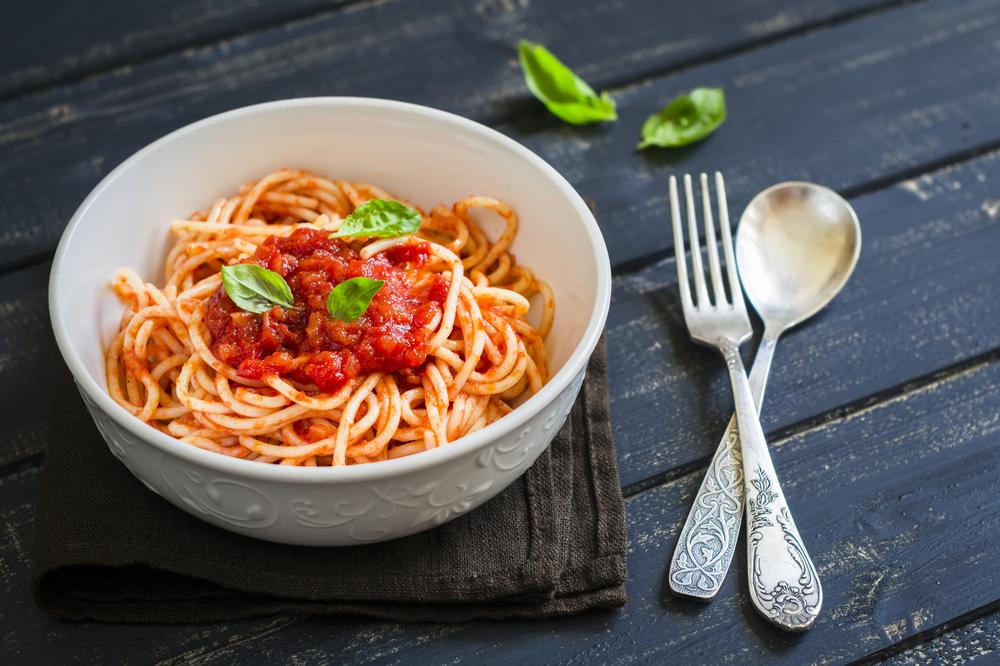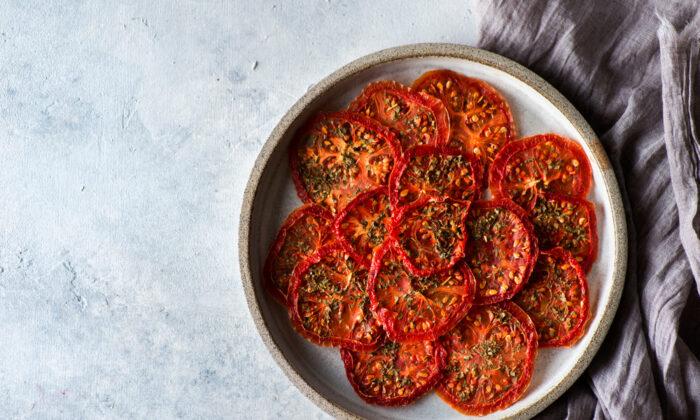The middle of winter can be a tough time for tomato lovers. We’re about as far away from the end of the previous season as we are from the beginning of the summer harvest, and no member of the produce kingdom suffers such a noticeable lack of flavor when it’s imported, out of season, from some faraway place. So this time of year, many people choose to simply forego tomatoes entirely, rather than suffer the indignity of a cardboard-flavored impostor.
Every summer, I do what I can to hang onto tomato season by preserving as many as I can, when the price is low and the quality is high. My storage form of choice has been an oven-roasted tomato sauce that I freeze, then use for pasta and pizza throughout the year. But the summer before last, a farmer friend offered me several boxes of tomatoes at a price I couldn’t refuse. So while I made my usual sauce, my wife tried her hand at something different.

She cut the tomatoes into thin slices, sprinkled the slices with salt, and laid them on a dehydrator tray. A few hours later, those juicy slices had dried into crispy tomato chips. They had a tangy flavor as bright as their color and made for a delicious snack. Dehydrated produce is generally more nutritious than its frozen counterpart. Nonetheless, we promptly forgot all about them.
The problem is that we couldn’t seem to find a place for these crunchy red disks. I tried crumbling them onto salad, marinating them in olive oil and spices, baking them onto pizza, and many other ways. While they always tasted good, nothing we did ever caught on, and they never got eaten. So they languished in the freezer until we ran out of tomato sauce and the kids wanted spaghetti.
Only then, after they spent a year and a half in the freezer, did I attempt to make sauce from my dehydrated tomatoes. And I was most pleased. The marinara was as smooth and vibrant as if I had made the sauce from fresh, ripe tomatoes. It had a fresher flavor than that of my frozen sauce. Most importantly—and tellingly—the children approved.
Dehydrating tomatoes takes much less time and work during the summer than making a sauce and doesn’t overheat the kitchen. In the winter, I have plenty of time to make a sauce and the opportunity to be more creative. By dehydrating the tomatoes, you can use them to make any sauce you might want during the off-season, instead of making a vat of just one sauce in fall, such as the marinara that I typically make.
The other day, I used different spices to make a rehydrated tomato sauce that was flavored with cumin instead of oregano. I used the sauce to make shakshuka, a Middle Eastern dish of eggs poached in tomato sauce. It tasted like summer shakshuka, seasoned with sunshine.
I’ve also begun using my dried tomatoes in soups, curries, and even stir-fries. They add their acidic tang to the meal while absorbing the surrounding juices and taking on the flavors around them.
Dried Tomato Sauce
This red sauce is bright and tangy, with a fresher taste than a sauce that was canned months ago. For an extra wintry touch, I’ve added shredded carrots, which will completely disappear into the sauce.- 1 ounce dried tomatoes
- 2 cups stock (I use chicken stock)
- 2 tablespoons olive oil
- 1 medium onion, minced
- 1 clove garlic, minced or pressed
- 1/2 cup finely grated carrot
- 1 tablespoon dried oregano
- 1 tablespoon red chile pepper powder or paprika or both
- 1/2 cup red wine
- 2 tablespoons wine vinegar
- Salt to taste
Add the olive oil to another pan and sauté the onion, garlic, and carrot. When the onions turn translucent, stir in the spices, then add the stock and tomatoes. Cook for about 5 minutes on medium heat, then turn off the heat and let it sit. When it’s cool enough to work with, add the contents of the pan to a blender and liquify.
Return the smooth sauce to the pan, add the wine, vinegar, and salt to taste. Your sauce is ready.

Shakshuka Variation
This Middle Eastern egg dish has developed something of a cult following in the United States in the past few years. The sauce ingredients are almost the same as the sauce above. Simply omit the shredded carrots and wine, and substitute 1 tablespoon cumin for the oregano. You’ll also need 2 to 4 eggs and a fresh garnish, such as parsley or cilantro.Add a cup of shakshuka sauce to a pan, along with a cup of water. Heat it to a simmer on medium-low heat.
Crack the eggs into a bowl, one at a time—it’s easier to gently pour an egg into a poaching liquid than to crack it in. Add the eggs to the pan of sauce, and when the eggs are simmering, keep an eye on them as they approach your desired state of cooked. Some people use a tight-fitting lid to do so, but by doing so you risk overcooking the eggs.
When the eggs are done to your liking, garnish with the fresh herbs and set the pan on a hot pad to use as a serving dish.





